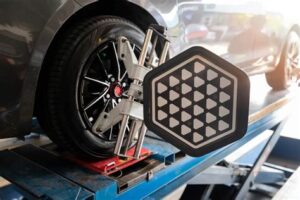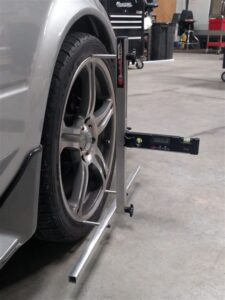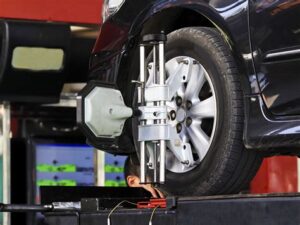Discover the causes of car pulling right, effects of misaligned wheels, and the benefits of professional alignment services for optimal vehicle performance.When you invest in a wheel alignment for your vehicle, you expect a smooth driving experience free from distractions. However, if you notice your car pulling to the right shortly after the service, it can be both concerning and frustrating. Understanding the underlying causes of this issue is crucial for maintaining your vehicle’s performance and ensuring your safety on the road. In this blog post, we’ll delve into the common reasons why your car might pull to the right after an alignment, the impact of misaligned wheels, and the effects of camber misalignment. We’ll also highlight the importance of proper wheel balancing and the benefits of seeking professional alignment services. By the end, you’ll be better equipped to address this nagging problem and keep your vehicle in top shape.
Causes of Car Pulling Right
Experiencing your car pulling right after an alignment can be quite frustrating. There are several potential causes for this issue, each of which can significantly impact your driving experience. Understanding these causes is essential not only for your comfort but also for your safety on the road.
One of the primary reasons your car may pull to the right is due to an imbalance in the wheel alignment. If the wheels are not aligned properly, they may not be pointing in the same direction, causing your vehicle to drift. Even the slightest misalignment can lead to noticeable pulling.
Another significant factor could be differences in tire pressure. If one side has lower tire pressure than the other, the vehicle will pull towards the side with the lower pressure. Regularly checking and maintaining the correct tire pressure is essential for even wear and optimal handling.
Moreover, worn-out or damaged suspension components such as tie rods and control arms can cause the steering to behave unpredictably, often resulting in a pull to one side. It’s crucial to inspect these parts regularly to ensure they are functioning properly.
| Cause | Description |
|---|---|
| Wheel Alignment | Improper alignment can lead to uneven tire wear and pulling. |
| Tire Pressure | Different tire pressures can cause the vehicle to drift to one side. |
| Suspension Wear | Worn components can affect steering and handling, causing pulling. |
Impact of Misaligned Wheels
When it comes to vehicle performance, one crucial aspect that is often overlooked is wheel alignment. Misaligned wheels can lead to a multitude of issues that not only affect the vehicle’s handling but also compromise safety. Understanding the impact of misaligned wheels is essential for any vehicle owner.
One of the most immediate effects of misaligned wheels is tire wear. If your wheels are not aligned correctly, the tires will wear unevenly, leading to a decrease in their lifespan. This can result in spending more money on replacements sooner than expected. The table below illustrates the common types of tire wear associated with misalignment:
| Type of Wear | Possible Cause |
|---|---|
| Inner Edge Wear | Excessive Camber Misalignment |
| Outer Edge Wear | Toe Misalignment |
| Center Wear | Over or Under Inflation |
Moreover, misaligned wheels can severely affect steering control. If your vehicle pulls to one side, it indicates that your alignment is off. This not only makes for an uncomfortable drive but can also result in an increased risk of accidents. Therefore, keeping your wheels properly aligned is critical not just for the vehicle’s performance but also for your safety on the road.
In summary, neglecting the importance of proper wheel alignment can lead to higher costs in tires, compromised vehicle handling, and increased accident risk. Therefore, regular checks and m
Effects of Camber Misalignment
Camber misalignment is a critical issue that can have significant effects on your vehicle’s handling, tire wear, and overall safety. When the camber angle deviates from the manufacturer’s specifications, typically due to suspension wear and tear or improper alignment, it can lead to a variety of driving problems.
One of the most noticeable effects of camber misalignment is uneven tire wear. When the camber angle is too positive or negative, the tires can make uneven contact with the road. This not only shortens the lifespan of your tires but can also lead to dangerous driving conditions. To illustrate this, consider the following table showing the effects of different camber angles:
| Camber Angle | Tire Wear Pattern | Potential Issues |
|---|---|---|
| Positive Camber | Outer edge wear | Reduced traction, instability |
| Negative Camber | Inner edge wear | Poor braking, steering issues |
Additionally, camber misalignment can drastically affect your vehicle’s handling and steering response. When driving, you might notice the vehicle pulling to one side, which can complicate maneuvers, especially in emergency situations. It’s crucial to address these issues promptly, as the longer you drive with misaligned camber, the more severe the damage can become.
In summary, ignoring the effects of camber misalignment can lead to uneven tire wear, decreased traction, and compromised safety. Regular wheel alignment checks are essential to ensure your vehicle operates smoothly and safely on the road.
Importance of Wheel Balancing
One of the most critical aspects of maintaining your vehicle’s performance and safety is wheel balancing. Properly balanced wheels ensure that your tires wear evenly and improve your vehicle’s handling characteristics. When wheels are unbalanced, it can lead to a host of issues that affect your driving experience.
Unbalanced wheels can cause vibrations, particularly at higher speeds, which not only impact comfort but also may lead to premature tire wear. Regular wheel balancing helps to prevent this by ensuring that the weight is evenly distributed around the tire and wheel assembly. This can save you money in the long run by extending the life of your tires.
In addition to cost savings, wheel balancing is essential for vehicle safety. Unbalanced wheels can affect steering precision, make driving more difficult, and increase the risk of tire blowouts. By prioritizing wheel balancing, you’re not only enhancing your vehicle’s performance but also ensuring a safer driving experience for you and your passengers.
Benefits of Professional Alignment Service
When it comes to the performance and safety of your vehicle, one critical aspect to consider is wheel alignment. Many drivers overlook this essential maintenance step, often waiting until they notice problems like the car pulling right or uneven tire wear. However, investing in a professional alignment service offers a multitude of benefits that can enhance your driving experience.
One of the primary benefits of a professional alignment service is improved tire longevity. Misalignment can cause tires to wear unevenly, leading to the need for frequent replacements. By ensuring that your wheels are properly aligned, you can help extend the lifespan of your tires, ultimately saving you money in the long run.
Moreover, a well-aligned vehicle contributes to better handling and improved fuel efficiency. When your wheels are aligned, your car will handle better during turns and maintain traction more effectively. This enhancement not only provides a smoother ride but also helps to maximize your fuel efficiency, making your driving experience both enjoyable and economical.
Additionally, a professional alignment service ensures that your vehicle’s suspension system is functioning properly, reducing wear and tear on other components. This proactive maintenance can help you avoid more extensive and costly repairs down the line, ensuring that your vehicle remains in peak condition.
Ultimately, opting for a professional alignment service is an investment in your vehicle’s performance and safety. It not only reduces the risk of uneven tire wear and handling issues but also enhances overall driving comfort. Don’t overlook the importance of keeping your wheels aligned; the benefits are too significant to ignore!
Frequently Asked Questions
What does it mean when a car pulls to the right after an alignment?
When a car pulls to the right after an alignment, it typically indicates that the wheels are not properly aligned or that there may be a difference in tire pressure or condition between the left and right tires.
What are the common causes of a car pulling to the right?
Common causes include improper wheel alignment, uneven tire pressure, worn suspension components, or even a brake issue on one side of the vehicle.
How can I tell if it’s my alignment or tires causing the pull?
You can check the tire pressure on both sides and inspect the tires for uneven wear. If the pressures are equal and the tires appear fine, then alignment is likely the issue.
Is it normal for a car to pull after alignment work?
While some minor adjustment may be normal, a significant pull indicates that something is wrong, and a professional should reassess the alignment.
What should I do if my car pulls to the right after a professional alignment?
Return to the alignment shop to have them inspect the alignment again and check for other issues that may be causing the pull.
Can external factors cause my car to pull to the right after alignment?
Yes, external factors such as road conditions or strong wind can temporarily affect the car’s steering, but if the pulling persists, further investigation is needed.
How often should I check my alignment to prevent pulling issues?
It’s recommended to check your alignment at least once a year or whenever you notice handling changes, tire wear, or after hitting a significant pothole or curb.





